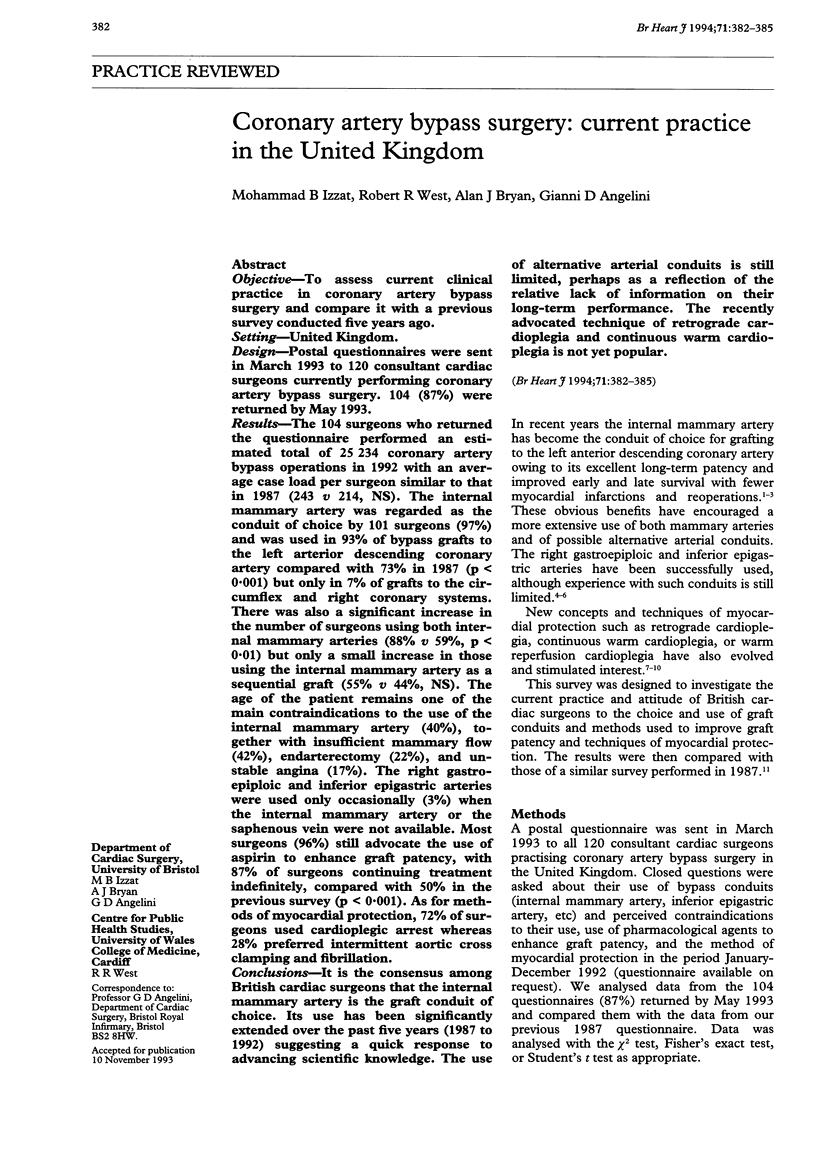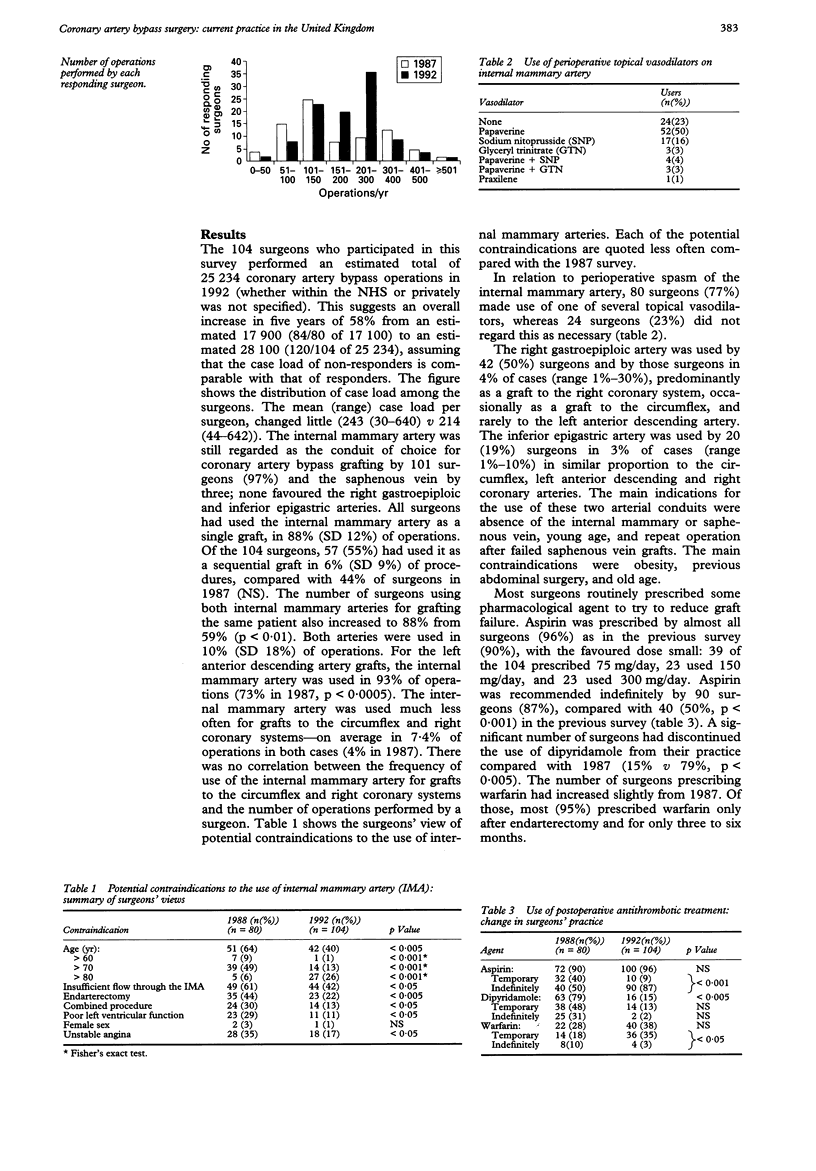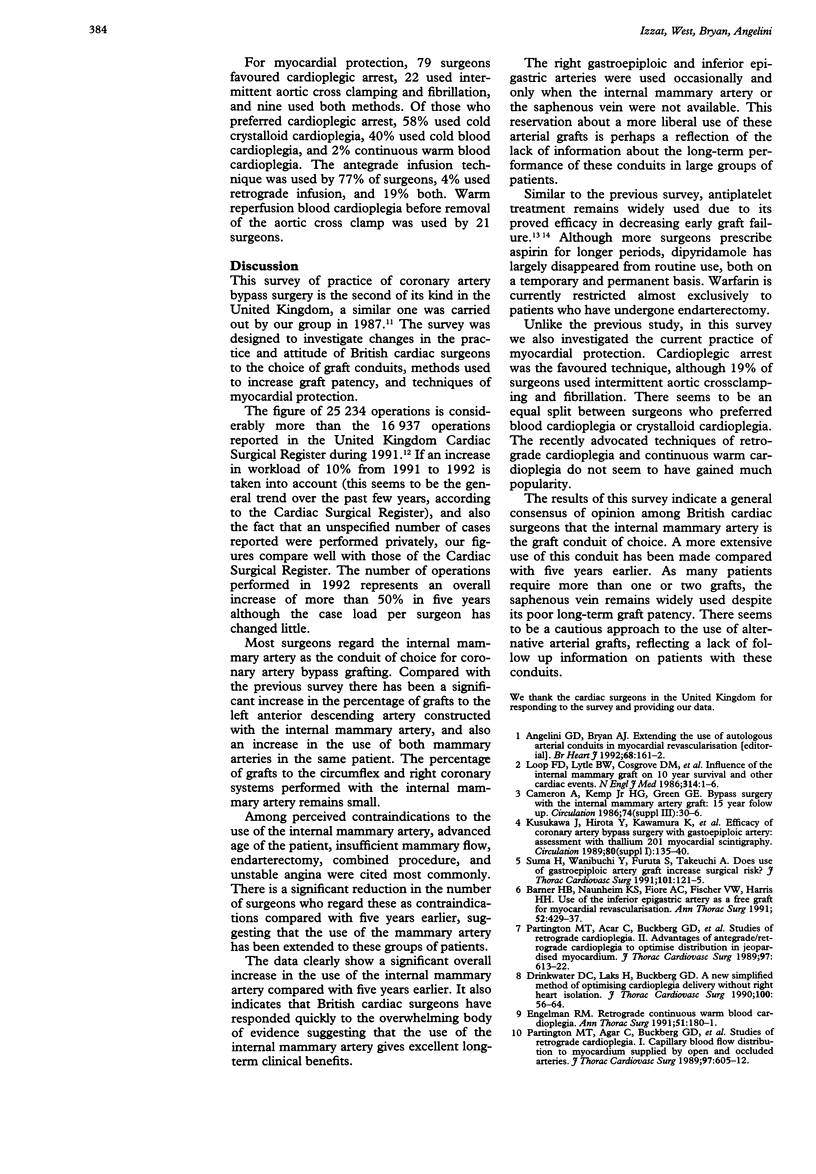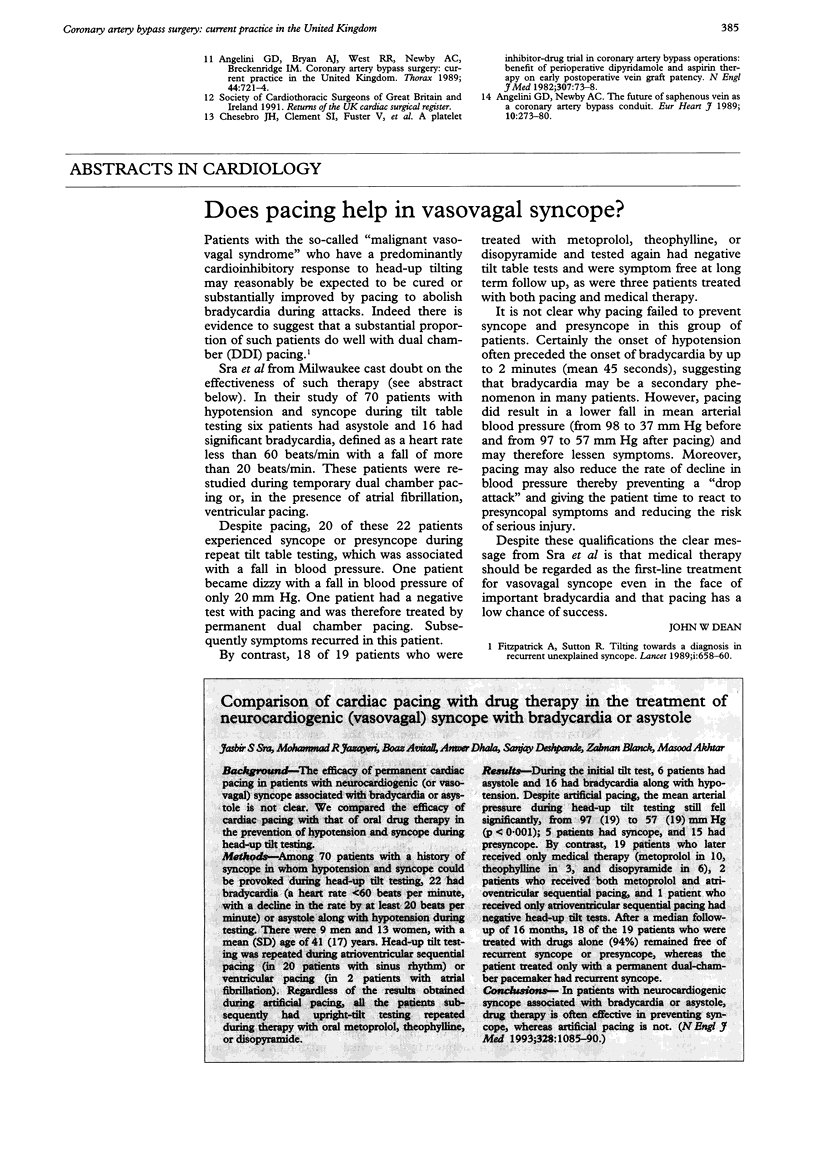Abstract
OBJECTIVE--To assess current clinical practice in coronary artery bypass surgery and compare it with a previous survey conducted five years ago. SETTING--United Kingdom. DESIGN--Postal questionnaires were sent in March 1993 to 120 consultant cardiac surgeons currently performing coronary artery bypass surgery. 104 (87%) were returned by May 1993. RESULTS--The 104 surgeons who returned the questionnaire performed an estimated total of 25,234 coronary artery bypass operations in 1992 with an average case load per surgeon similar to that in 1987 (243 v 214, NS). The internal mammary artery was regarded as the conduit of choice by 101 surgeons (97%) and was used in 93% of bypass grafts to the left anterior descending coronary artery compared with 73% in 1987 (p < 0.001) but only in 7% of grafts to the circumflex and right coronary systems. There was also a significant increase in the number of surgeons using both internal mammary arteries (88% v 59%, p < 0.01) but only a small increase in those using the internal mammary artery as a sequential graft (55% v 44%, NS). The age of the patient remains one of the main contraindications to the use of the internal mammary artery (40%), together with insufficient mammary flow (42%), endarterectomy (22%), and unstable angina (17%). The right gastroepiploic and inferior epigastric arteries were used only occasionally (3%) when the internal mammary artery or the saphenous vein were not available. Most surgeons (96%) still advocate the use of aspirin to enhance graft patency, with 87% of surgeons continuing treatment indefinitely, compared with 50% in the previous survey (p < 0.001). As for methods of myocardial protection, 72% of surgeons used cardioplegic arrest whereas 28% preferred intermittent aortic cross clamping and fibrillation. CONCLUSIONS--It is the consensus among British cardiac surgeons that the internal mammary artery is the graft conduit of choice. Its use has been significantly extended over the past five years (1987 to 1992) suggesting a quick response to advancing scientific knowledge. The use of alternative arterial conduits is still limited, perhaps as a reflection of the relative lack of information on their long-term performance. The recently advocated technique of retrograde cardioplegia and continuous warm cardioplegia is not yet popular.
Full text
PDF



Selected References
These references are in PubMed. This may not be the complete list of references from this article.
- Angelini G. D., Bryan A. J. Extending the use of autologous arterial conduits in myocardial revascularisation. Br Heart J. 1992 Aug;68(2):161–162. doi: 10.1136/hrt.68.8.161. [DOI] [PMC free article] [PubMed] [Google Scholar]
- Angelini G. D., Bryan A. J., West R. R., Newby A. C., Breckenridge I. M. Coronary artery bypass surgery: current practice in the United Kingdom. Thorax. 1989 Sep;44(9):721–724. doi: 10.1136/thx.44.9.721. [DOI] [PMC free article] [PubMed] [Google Scholar]
- Angelini G. D., Newby A. C. The future of saphenous vein as a coronary artery bypass conduit. Eur Heart J. 1989 Mar;10(3):273–280. doi: 10.1093/oxfordjournals.eurheartj.a059476. [DOI] [PubMed] [Google Scholar]
- Barner H. B., Naunheim K. S., Fiore A. C., Fischer V. W., Harris H. H. Use of the inferior epigastric artery as a free graft for myocardial revascularization. Ann Thorac Surg. 1991 Sep;52(3):429–437. doi: 10.1016/0003-4975(91)90902-3. [DOI] [PubMed] [Google Scholar]
- Chesebro J. H., Clements I. P., Fuster V., Elveback L. R., Smith H. C., Bardsley W. T., Frye R. L., Holmes D. R., Jr, Vlietstra R. E., Pluth J. R. A platelet-inhibitor-drug trial in coronary-artery bypass operations: benefit of perioperative dipyridamole and aspirin therapy on early postoperative vein-graft patency. N Engl J Med. 1982 Jul 8;307(2):73–78. doi: 10.1056/NEJM198207083070201. [DOI] [PubMed] [Google Scholar]
- Drinkwater D. C., Laks H., Buckberg G. D. A new simplified method of optimizing cardioplegic delivery without right heart isolation. Antegrade/retrograde blood cardioplegia. J Thorac Cardiovasc Surg. 1990 Jul;100(1):56–64. [PubMed] [Google Scholar]
- Engelman R. M. Retrograde continuous warm blood cardioplegia. Ann Thorac Surg. 1991 Feb;51(2):180–181. doi: 10.1016/0003-4975(91)90777-n. [DOI] [PubMed] [Google Scholar]
- Loop F. D., Lytle B. W., Cosgrove D. M., Stewart R. W., Goormastic M., Williams G. W., Golding L. A., Gill C. C., Taylor P. C., Sheldon W. C. Influence of the internal-mammary-artery graft on 10-year survival and other cardiac events. N Engl J Med. 1986 Jan 2;314(1):1–6. doi: 10.1056/NEJM198601023140101. [DOI] [PubMed] [Google Scholar]
- Partington M. T., Acar C., Buckberg G. D., Julia P. L. Studies of retrograde cardioplegia. II. Advantages of antegrade/retrograde cardioplegia to optimize distribution in jeopardized myocardium. J Thorac Cardiovasc Surg. 1989 Apr;97(4):613–622. [PubMed] [Google Scholar]
- Partington M. T., Acar C., Buckberg G. D., Julia P., Kofsky E. R., Bugyi H. I. Studies of retrograde cardioplegia. I. Capillary blood flow distribution to myocardium supplied by open and occluded arteries. J Thorac Cardiovasc Surg. 1989 Apr;97(4):605–612. [PubMed] [Google Scholar]
- Suma H., Wanibuchi Y., Furuta S., Takeuchi A. Does use of gastroepiploic artery graft increase surgical risk? J Thorac Cardiovasc Surg. 1991 Jan;101(1):121–125. [PubMed] [Google Scholar]


